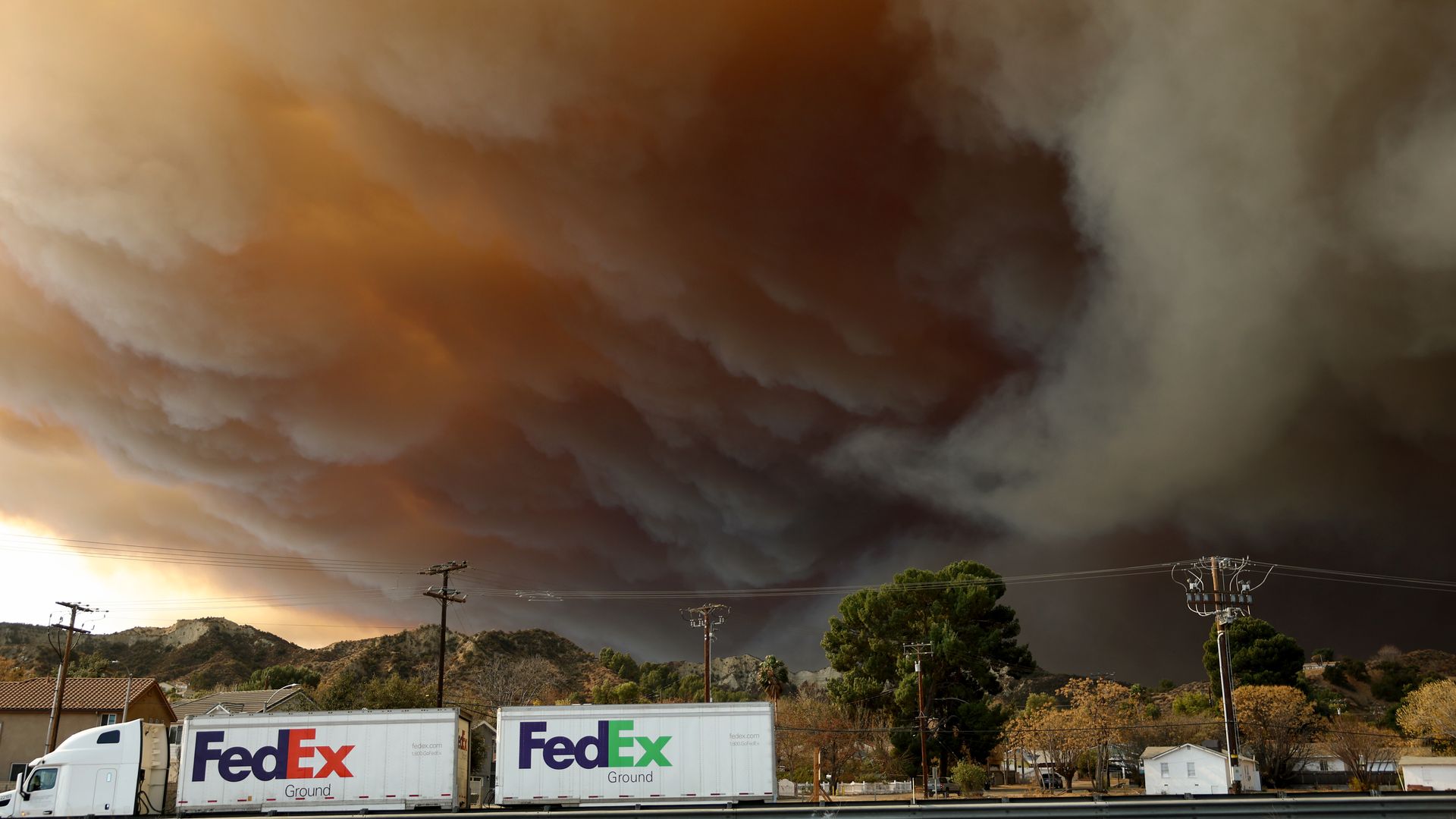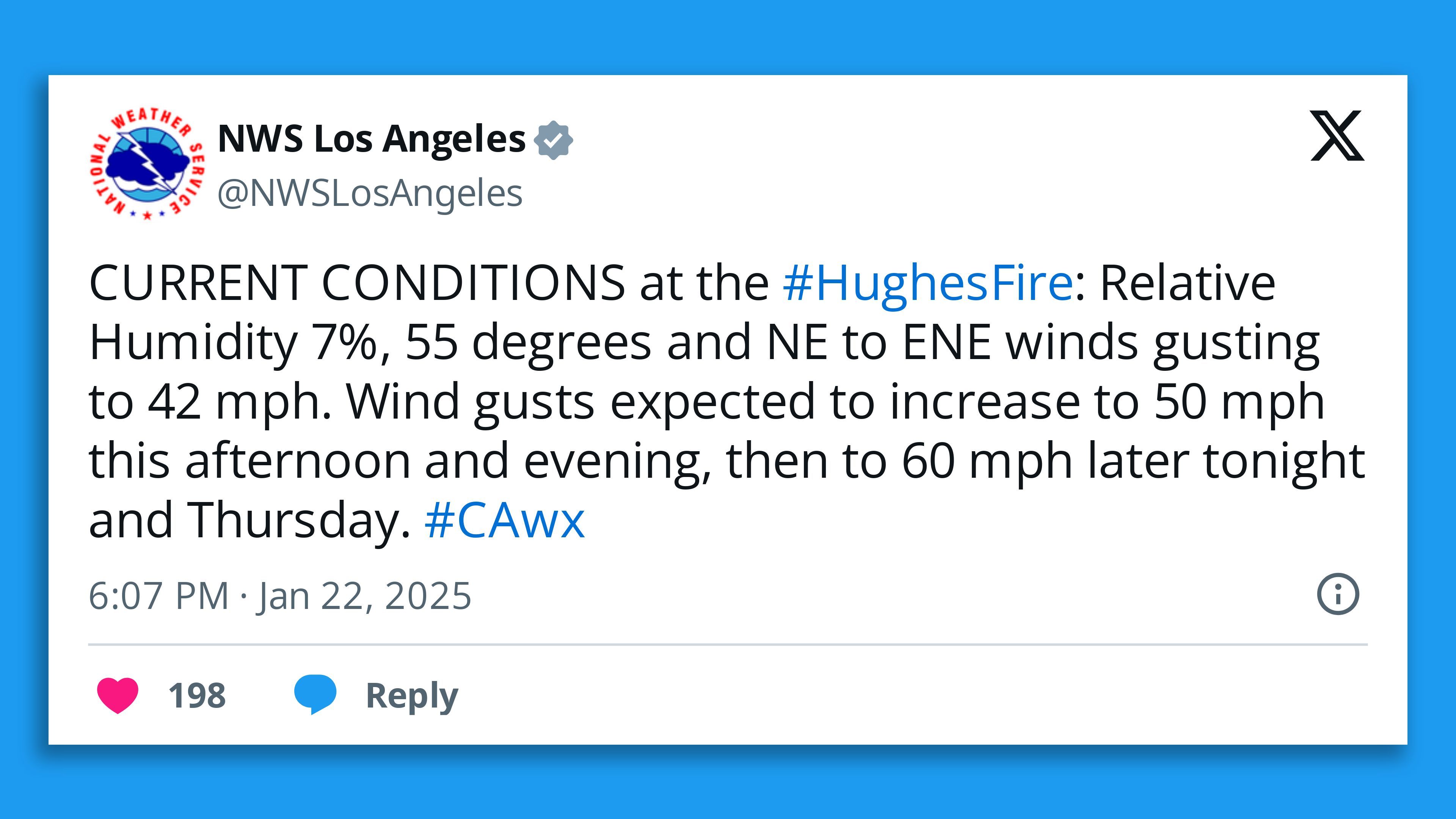Thousands evacuate Hughes Fire near LA as California faces fresh threats

The Hughes Fire burns north of Los Angeles on January 22, 2025 near Castaic, California. Photo: Mario Tama/Getty Images
A fresh California wildfire ignited north of Los Angeles Wednesday during critical fire weather and triggered evacuations as it quickly exploded in size across two counties on Wednesday — and forecasters warned conditions would worsen overnight.
The big picture: The Hughes Fire ignited north of Santa Clarita, just before 11am Wednesday local time and grew across 5,000 acres in LA and Ventura Counties in just over two hours — making it the biggest and fastest-spreading wildfire since the still-burning Eaton and Palisades Fires erupted on Jan. 7.
- The fire that's near the popular water reservoir Castaic Lake some 40 miles from those blazes had grown to an estimated 10,176 acres at 14% containment just before 10pm, as Southern California faced more Santa Ana winds and red flag warnings were in effect.
- The blaze in the San Gabriel Mountains has prompted authorities to close all northbound lanes on Interstate 5 from just north of State Route 126 and issue smoke, windblown dust and ash advisories
Thousands evacuate Hughes Fire near LA as California faces fresh threats

The Hughes Fire burns north of Los Angeles on January 22, 2025 near Castaic, California. Photo: Mario Tama/Getty Images
A fresh California wildfire ignited north of Los Angeles Wednesday during critical fire weather and triggered evacuations as it quickly exploded in size across two counties on Wednesday — and forecasters warned conditions would worsen overnight.
The big picture: The Hughes Fire ignited north of Santa Clarita, just before 11am Wednesday local time and grew across 5,000 acres in LA and Ventura Counties in just over two hours — making it the biggest and fastest-spreading wildfire since the still-burning Eaton and Palisades Fires erupted on Jan. 7.
- The fire that's near the popular water reservoir Castaic Lake some 40 miles from those blazes had grown to an estimated 10,176 acres at 14% containment just before 10pm, as Southern California faced more Santa Ana winds and red flag warnings were in effect.
- The blaze in the San Gabriel Mountains has prompted authorities to close all northbound lanes on Interstate 5 from just north of State Route 126 and issue smoke, windblown dust and ash advisories.

What they're saying: LA County Sheriff Robert Luna said at a Wednesday briefing that some 31,000 people were under mandatory evacuation orders and a further 23,000 were under evacuation warnings.
- "The situation remains dynamic, and the fire remains a difficult fire to contain, although we are getting the upper hand," Marrone said.
Threat level: Warm, and dry conditions were expected to continue through Thursday, per a forecast discussion from the National Weather Service's Los Angeles office.
- "While the risk of wildfire spread will be high throughout the period, conditions will be increasingly dangerous tonight into Thursday when wind speeds of 30-50 mph and gusts approaching 70 mph are possible," the NWS' Storm Prediction Center said on X.
- UCLA climate scientist Daniel Swain said during a Wednesday briefing the region was facing a "potentially record warm, dry and windy" period ahead of forecast rain over the weekend, "so that's one reason why the current fire is major concern."
Zoom out: Firefighters continued to make progress in the destructive and deadly Palisades and Eaton fires in Los Angeles County despite the challenging conditions.
- The Palisades Fire was burning across 23,448 acres at 70% containment on Wednesday night.
- The Eaton Fire was over 14,021 acres and was 95% contained.
Between the lines: This extreme weather event is partly related to the Arctic blast that's impacting most of the Lower 48 states, with cold air surging into the Great Basin helping to fuel dry, offshore winds across Southern California.
- The region is suffering from hydroclimate whiplash worsened by human-caused climate change, having seen two wet winters followed by a bone-dry, unusually hot spring, summer and fall.
- Many parts of Southern California have had their driest start to the wet season on record. Only 0.16 inches of rain has fallen in LA since May 6.
- Much of the region has been experiencing "moderate drought" conditions, per the U.S. Drought Monitor.
What's next: "A significant cooling trend will begin Friday and continue through the weekend as a cold storm system moves over the region," according to the NWS LA's forecast discussion.






0 মন্তব্যসমূহ